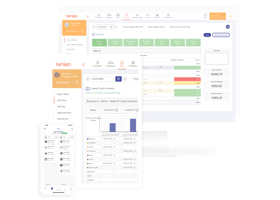This is our Service
Level Agreement.
Service Level Agreement
Last updated 6th of May 2018
1. System availability
System availability is measured in terms of uptime over one month. Uptime is measured by an independent third party (Host Tracker) and is defined as ability to access the web application.
The guaranteed monthly uptime is 99.5%.
This uptime guarantee covers the following web applications:
— Main web application (app.tamigo.com)
— tamigo Touch (touch.tamigo.com)
— Website (www.tamigo.com)
a. Exceptions:
Downtime caused by any of the following is not included when measuring uptime.
1. General internet issues, including congestion or general DNS services not directly relating to tamigo or services provided by tamigo.
2. Force majeure events as described in the terms of agreement.
3. Actions or inactions of the Customer (unless undertaken at the express direction of tamigo) or third parties beyond the control of tamigo.
Note: Subcontractors of tamigo are not considered a third party and tamigo takes full responsibility for subcontractors.
4. A result of Customer equipment or third party computer hardware, software, or network infrastructure not within the sole control of tamigo.
5. Scheduled SaaS infrastructure maintenance.
b. Compensation:
If uptime is lower than guaranteed in a certain month, the customer will be compensated with a reduced price per user in that month. Compensated Downtime is calculated as the maximum of (guaranteed uptime – actual uptime) across all of the sites.
Prices will be reduced with 5% for every 0.1 percentage point of Compensated Downtime. If for example the main application has uptime of 100%, touch application has uptime of 99.2% and website has up time of 99.4%, the compensated downtime will be maximum of (99.5%-99.2%) and (99.5%-99.4%), which is then 0.3%, and prices will be reduced with 15% for that month. The maximum price reduction will be 100%.
c. Reporting:
tamigo will provide monthly overviews of uptime for each application upon request from the Customer.
2. Support availability
Support can be accessed by named individuals as agreed between tamigo and the Customer.
Support can be accessed in the following ways:
— Phone support, from 09:00 to 16:00, Monday to Friday.
— Email support, from 09:00 to 16:00, Monday to Friday.
3. Incident management
This section details the service targets for Incident Management in tamigo.
Incidents are addressed within 24 hours (within office hours).
Problems are categorised and handled as described in tamigo Incident Management.
Service targets in this SLA for each category:
— No. 5: A problem that causes tamigo to be inaccessible.
Service target: Resolution begins immediately even if outside office hours and continues until solved.
— No. 4: A problem that causes a feature in tamigo to be inaccessible.
Service target: This is solved in the current development cycle, or sooner. Max. resolution time: 14 days. Expected resolution time: 2 days.
— No. 3: A problem that affects the customer’s ability to use tamigo.
Service target: This is scheduled upon identification in collaboration with the customer. It is determined on a case by case basis, but normally is scheduled for the next development cycle.
— No. 2: A minor problem that does not severely affect the customer’s ability to use tamigo effectively. No workaround.
Service target: This is scheduled upon identification in collaboration with the customer. It is determined on a case by case basis, but normally is scheduled for the next development cycle.
— No. 1: A minor problem that does not severely affect day-to-day business for the customer. With a workaround.
Service target: This is scheduled by tamigo based on feedback from the Customer and considering the inconvenience of the workaround.
4. Backup & contingency plans
All data is backed up in three levels, making sure that substantial data loss is not possible.
1. For essential data, single entities are logged directly in the database in order to be able to restore accidentally deleted data or for revision tracking.
2. The complete servers, including OS, are backed up nightly, providing an extremely fast and dependable method of restoring normal operations in case of catastrophic partial failure.
3. In case of a catastrophic failure, i.e. flooding in the data centre or other factors causing severe hardware malfunction, rendering the main hosting centre unoperational, tamigo has remote nightly backups. These can be used to restore normal operations. tamigo has a secondary data centre, which can be used in case the primary data centre is not operational within reasonable time.
Upon catastrophic failure, the upper maximum limit for data loss is 24 hours. This is extremely unlikely. Procedures for catastrophic failure is simulated and tested annually.



